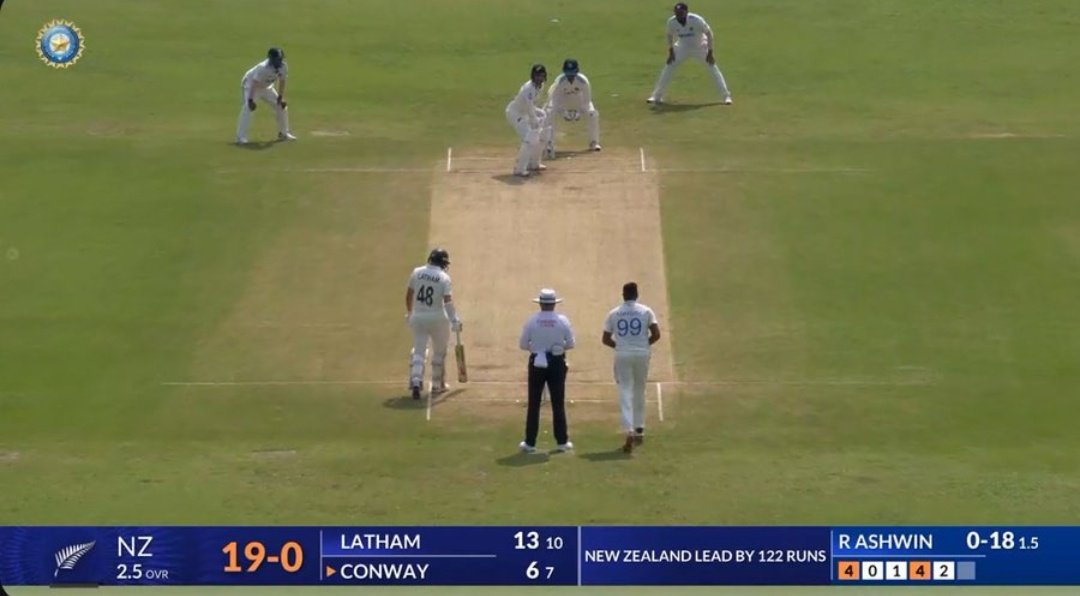
It all started from the toss in the first game at Bengaluru when Rohit opted to bat first in seaming conditions, only to bundle on 46.

It was just the third over of New Zealand’s second innings after they had gained a formidable 103-run lead in the first dig. Ideally, a captain would want his spinners to attack on an assisting track with a short leg, silly point or silly mid-off and an extra slip fielder. However, Rohit only gave one slip and one backward square leg.
By having a backward square leg, he clearly had the openers’ sweep shots in mind, which they employed from the first ball. Rohit kept a forward short leg for the first ball of this innings, but all it took was one paddle sweep behind square to remove that fielder and bring it squarer to stop that shot.

He was ball chasing immediately. Later, he removed all close-in fielders and just went with one slip, standing himself in that position, in just the sixth over the innings. Now New Zealand are smart enough not to search for boundaries, and the field spread ensured they had singles and doubles easily.
They were happy to manoeuvre the field and chip away with crucial runs. But if Rohit had put close-in fielders, they would have to take more risk automatically. It’s not that New Zealand raced away to a good score and scored at run-a-ball or anything.
Maybe Rohit didn’t want the opponent to score too many and completely put them out of the game. But the worst part was that the Kiwi batters adeptly took doubles in the middle even after defensive fieldsets. Even new batters settled in pretty quickly by rotating the strike. Further, Indian spinners, especially Ravindra Jadeja and Ravichandran Ashwin, bowled enough loose deliveries to let the opponent get easy boundaries.
Also Read: So much talk around the pitch, little around India’s incompetency vs spin
Similarly, Tom Blundell played a reverse sweep every second or third delivery from the start of his innings, but Rohit didn’t do anything different to stop that. He could have put fielders at gully and a shortish third man to cut that shot that reaped ample runs. Rachin Ravindra was allowed to drive and take a single from the long-on region on just his second delivery of the first innings in the Pune Test.
It all started from the toss in the first game at Bengaluru when Rohit opted to bat first in seaming conditions, only to bundle on 46. Maybe that wasn’t his fault completely, but you’d still expect the home captain to read its conditions well. However, during the second innings, he let New Zealand score 402 when they were reeling at 233/7, with Rachin Ravindra and Tim Southee forming a massive 137-run partnership for the eighth wicket.
Rohit didn’t bring Bumrah for a short spell at any point and introduced him once the partnership became 120 and the new ball was taken. It’s not that the captain cared about his workload, either.
He gave Bumrah a big 8-over spell in the fourth innings of the same game while delaying Ravichandran Ashwin’s entry till the 25th over, and by then, the Kiwis only required 10 more runs to win. Ashwin averages 19.12 overall and 16.90 at home in the fourth innings.
Even if he wanted to continue with Bumrah, the Indian captain could have opted to bring Ashwin from the other and at least see what he was doing. It’s not that bowlers from the non-Bumrah end were penetrative, either. Whenever India have required breakthroughs, Rohit has turned to Bumrah and given him an extended spell. And when it was actually needed, he brought everyone but Bumrah.
Even the team combination and batting orders have been perplexing. And Rohit is not completely responsible for that. Gautam Gambhir and co. were also involved in those decisions.
Also Read: Washington Sundar as an all-rounder, finally?
India played three spinners on that seaming deck in Bengaluru when they should have opted for an additional pacer. Sarfaraz Khan, not too solid against pace, was sent ahead of better players of pace Rishabh Pant and KL Rahul at No.4 in the first innings. That might not have made much difference, but the process is controllable.
Later, in the second game, Sarfaraz came at No.6 in the first innings, while Washington Sundar batted at No.9, below Ravindra Jadeja and Ravichandran Ashwin. He is more than capable with the bat and should bat ahead of other spin-bowling all-rounders. Further, Sundar was promoted to No.6, with Sarfaraz Khan at No.7.
Too much focus has been on maintaining the LHB-RHB combination when it’s not really necessary in red-ball cricket. That has some Gautam Gambhir influence. His obsession with this has already shown its drawbacks.
How can a batter succeed without getting a settled number? His press conferences have also been contradicting his decisions in the match. He said he would back KL Rahul, only to drop him from the playing XI.
That was the right decision, but why would you say something opposite in the press conference? How’s that going to bring stability within the group?
“Aggressive cricket” is a term used by the new management at every turn, but it’s hard to see it happening on the field. Maybe batting aggressively against a depleted bowling attack for an innings doesn’t make a team aggressive. Neither does shuffling too many batting positions in each game.
There have been ominous signs for a while now, but a few individual flashes of brilliance saved them every time. Just when that didn’t happen in this series, the unthinkable happened. Maybe 12 saal mein ek baar allowed hai, but faulty decisions, which have been aplenty, are not allowed.
For more updates, follow CricXtasy on Facebook, Instagram, Twitter, Telegram, and YouTube.